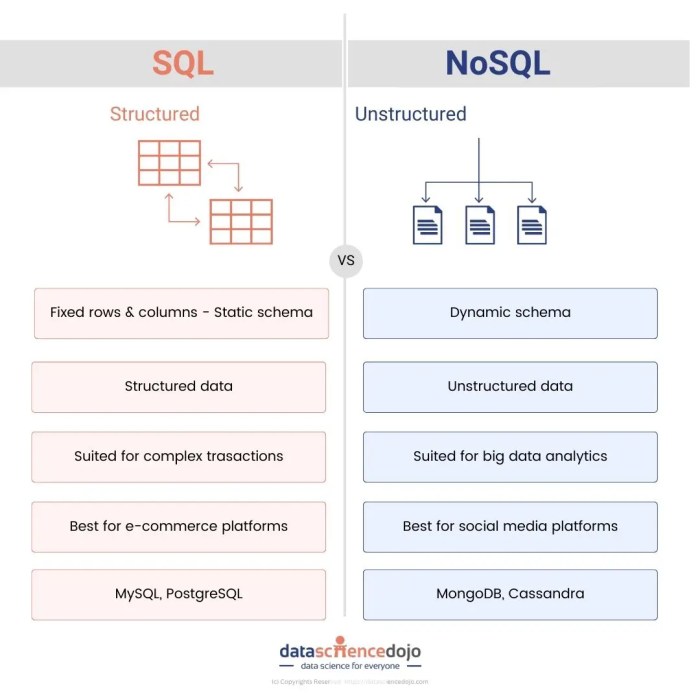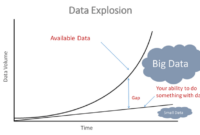Delving into SQL vs NoSQL databases, this introduction immerses readers in a unique and compelling narrative. We explore the fundamental differences between these two database types, shedding light on their structures, use cases, and scalability.
As we delve deeper, we uncover the key aspects of data models, performance, and scalability, providing valuable insights to help you choose the right database solution for your needs.
SQL Databases
SQL databases, also known as relational databases, use structured query language (SQL) for defining and manipulating data. They are based on the relational model and have a predefined schema that defines the structure of the data.
Structure of SQL Databases
SQL databases organize data in tables, where each table consists of rows and columns. The columns represent the attributes or fields of the data, while the rows contain the actual data records. Relationships between tables are established using keys, such as primary keys and foreign keys.
Typical Use Cases of SQL Databases
SQL databases are commonly used in applications where data integrity, consistency, and ACID (Atomicity, Consistency, Isolation, Durability) compliance are essential. They are suitable for transactional systems, financial applications, e-commerce platforms, and any scenario requiring complex queries and joins.
Scalability of SQL Databases vs NoSQL Databases, SQL vs NoSQL databases
While SQL databases are known for their strong consistency guarantees and robust transaction support, they can face scalability challenges when dealing with massive amounts of data or high concurrency. Horizontal scaling, or sharding, can be used to distribute the load across multiple servers, but it may introduce complexities in maintaining data consistency.
NoSQL Databases: SQL Vs NoSQL Databases

NoSQL databases, also known as “not only SQL,” are a type of database management system that provides a mechanism for storage and retrieval of data that is modeled in means other than the tabular relations used in relational databases. NoSQL databases are generally more flexible, scalable, and better suited for handling large volumes of unstructured or semi-structured data compared to traditional SQL databases.
Types of NoSQL Databases
- Document Stores: Store data in flexible, JSON-like documents.
- Key-Value Stores: Simple key-value pairs for storage and retrieval.
- Column Family Stores: Data stored in columns rather than rows.
- Graph Databases: Focus on relationships between data points.
Advantages of Using NoSQL Databases over SQL Databases
NoSQL databases offer several advantages over SQL databases, including:
- Scalability: NoSQL databases are designed to scale horizontally, making it easier to handle large amounts of data and traffic.
- Flexibility: NoSQL databases can handle unstructured data types and are more adaptable to changing data requirements.
- Performance: NoSQL databases can provide faster read and write operations, especially for large-scale applications.
- Cost-Effectiveness: NoSQL databases can often be more cost-effective to operate at scale compared to traditional SQL databases.
Popular NoSQL Databases
- MongoDB: A widely-used document-oriented database.
- Cassandra: A distributed database system designed for scalability and high availability.
- Redis: An open-source, in-memory data structure store.
- Neo4j: A graph database that focuses on storing and querying graph data models.
Data Model

When comparing SQL and NoSQL databases, one of the key differences lies in their data models. SQL databases follow a structured, tabular format, while NoSQL databases offer more flexibility in data modeling.
Data Storage and Retrieval in SQL Databases
In SQL databases, data is stored in tables with predefined schemas. Each row represents a record, and columns represent attributes. Data retrieval is done using SQL queries, which allow for complex joins and transactions. This structured approach ensures data integrity and consistency.
Flexibility of Data Modeling in NoSQL Databases
NoSQL databases, on the other hand, do not require a fixed schema. They can adapt to different types of data and allow for dynamic schema changes. NoSQL databases support various data models like document, key-value, column-family, and graph databases, providing the flexibility to choose the best model for specific use cases.
Suitability of Data Models
- SQL databases are suitable for applications that require ACID compliance, complex queries, and transactions. For example, financial systems, e-commerce platforms, and legacy systems benefit from the structured nature of SQL databases.
- NoSQL databases are ideal for scenarios where scalability, flexibility, and fast data access are essential. Use cases like social media platforms, IoT applications, real-time analytics, and content management systems can leverage the diverse data models offered by NoSQL databases.
Performance and Scalability

When it comes to performance and scalability, SQL and NoSQL databases have distinct characteristics that impact their efficiency in handling data.
Performance Differences
SQL databases are known for their strong consistency and ACID properties, which ensure data integrity but can impact performance when dealing with high transaction volumes. On the other hand, NoSQL databases focus on scalability and flexibility, sacrificing some consistency in favor of faster performance.
- SQL databases are optimal for complex queries and transactions that require strong consistency.
- NoSQL databases are better suited for read-heavy workloads and applications that prioritize speed over strict consistency.
Scalability with Increased Data Volume
SQL databases typically scale vertically by adding more resources to a single server, which can be costly and have limits. NoSQL databases, on the other hand, are designed to scale horizontally by adding more servers to distribute the load, allowing for seamless expansion as data volume grows.
- Vertical scaling in SQL databases can lead to performance bottlenecks and downtime when reaching server limits.
- Horizontal scaling in NoSQL databases enables effortless distribution of data across multiple nodes, ensuring high availability and scalability.
Impact of Schema Flexibility
NoSQL databases offer schema flexibility, allowing for dynamic changes in data structure without affecting performance. This flexibility can be advantageous for agile development and adapting to evolving data requirements. However, it can also lead to data inconsistencies and require careful management to maintain performance efficiency.
Optimizing performance in NoSQL databases involves proper indexing, data denormalization, and efficient query design to leverage the benefits of schema flexibility without sacrificing speed.
Best Practices for Optimization
In SQL databases, optimizing performance involves proper indexing, query tuning, and normalization to reduce redundancy and improve query execution speed. For NoSQL databases, denormalization, sharding, and distributed caching are key strategies to enhance performance and scalability.
- Regularly monitor database performance metrics and fine-tune queries for optimal execution.
- Utilize caching mechanisms, such as Redis or Memcached, to reduce query load and improve response times.
- Implement partitioning and sharding techniques in NoSQL databases to evenly distribute data and queries across multiple nodes.
In conclusion, the debate between SQL and NoSQL databases continues to evolve, with each offering distinct advantages and considerations. Whether you prioritize structured data or require flexibility and scalability, understanding the nuances of these database models is crucial in the ever-changing landscape of data management.
When it comes to real-time data storage solutions, businesses are constantly seeking efficient and reliable options. One popular choice is the Real-time data storage solutions that offer seamless integration and fast access to information.
For those looking for a robust storage solution, HBase is a top contender. With its scalability and high performance, HBase storage solution is ideal for handling large volumes of data in real-time.
Amazon S3 storage is a popular choice for businesses of all sizes due to its flexibility and scalability. With Amazon S3 storage , companies can securely store and retrieve data in real-time, ensuring smooth operations.



